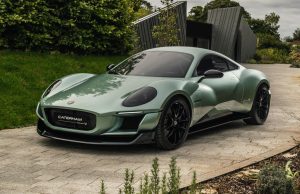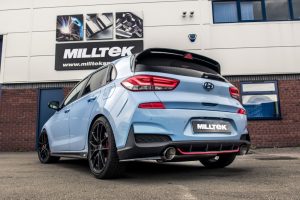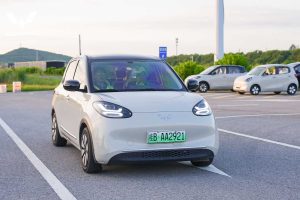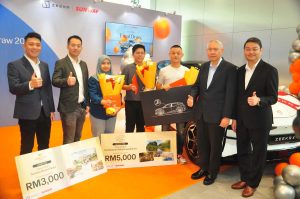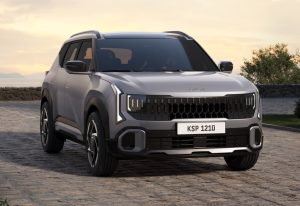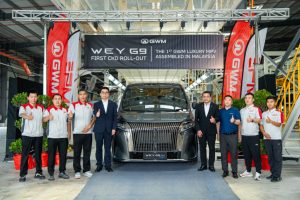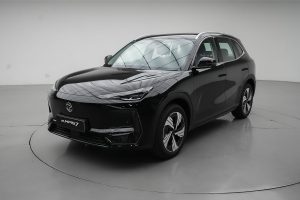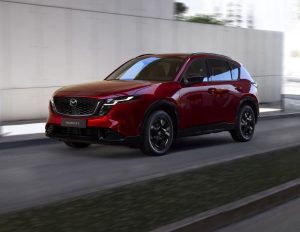THREE days spent with the Honda WR-V RS range-topping variant certainly made for enjoyable drives for us in commuting to work and running our daily errands.
The WR-V (Winsome Runabout Vehicle) which enters the local market in the small sports utility vehicle (SUV) segment, ticked all the right boxes for us – it’s agile, nimble and handles well enough at speed on curvy roads.
Also, the high quality interior is comfortable and its compact size makes it easier to manoeuvre in crowded commercial areas compared with larger SUVs.

The exterior looks attractively stylish and sporty, and it’s noteworthy that rear door handles are on the side of the window frame like the HR-V’s.
The black-themed cabin with mixed leather/fabric upholstery provides ample comfort for long drives.
Red stitchings on the upholstery lend a sporty look which also differentiates the RS grade from the other WR-V variants.

The WR-V is based on a shortened platform of the BR-V, and in terms of size, its rival here is the Perodua Ativa.
The WR-V is 70mm wider (presumably resulting in more shoulder room) than the Ativa, but is slightly shorter in length and wheelbase.
Ground clearance on the WR-V is 7mm higher, while it is 59mm lower in overall vehicle height than the Ativa.

Four WR-V variants are offered here priced from RM89,900 to RM107,900.
All variants are powered by a 1.5-litre DOHC i-VTEC engine with 121PS and 145Nm of torque, mated to a continuous variable transmission (CVT).
This would be a familiar mill to many, as it is also in the Honda City, City Hatchback and HR-V (S variant)

Extra kit on the range-topping RS grade includes RS badging and touches, 17-inch dual-tone alloy wheels (instead of 16-inch wheels), front LED sequential turn signals, paddle shifters, six audio speakers (instead of two on the S, and four on the E and V grades), and six airbags (instead of four).
Also exclusive on the RS grade is the Honda Connect telematics system which is accessible via a smartphone app.
Honda Connect provides safety, security and convenience functions which can be accessed remotely by the car owner.

These functions include automatic collision detection and call for help, automatically sending an alert when the security alarm is triggered by trespassers, sending a speed alert notification if someone who borrowed your car exceds a pre-set limit, Find My Car, and geo-location which sends alerts when the car enters or exits a preset zone, and service reminders.
After getting inside, you are greeted – as the driver’s door closes – by a musical chime as the RS letters flash on the 4.2-inch TFT multi-information display (between two analogue dials) TFT display, and the engine start/stop button starts flashing white.
There is a high quality impression for the interior fit and finish, and the dashboard layout looks nice and clean in the typical Honda manner.

The WR-V has a traditional hand brake lever, while front seatback pockets, door bins, and a centre storage box (between the front seats) provide storage options for small items.
The front sports seats held our bodies snugly, and we also found ample leg and shoulder room in the rear.
Still, rear headroom is just adequate for 1.7-metre tall adults.

Rear cargo space is 380 litres, and this can be expanded with the 60:40 folding rear seats, although you don’t get Honda’s famed Ultra Seats for versatile storage configuration.
Honda has said Ultra Seats are not fitted here, in order to reduce weight and gain better fuel efficiency.
Having Ultra Seats would require a centre fuel tank layout that must be reinforced, which in turn adds weight.

Meanwhile, the WR-V recorded our fuel consumption at 12.8km per litre (compared with Honda’s claim of 16.67km per litre), after driving nearly 198km on a mix of highways and roads in urban townships.
The remaining travel range before needing to refuel, was 226km (from 443km when we first took the car).
We did not attempt to drive in a fuel sipping manner, and on the contrary, were quite heavy-footed and impatient drivers especially in stop-and-go traffic.
It’s also worth noting that our RS grade tester is the heaviest WR-V variant, and this small SUV tips the scales from 1,108kg to 1,145kg for the S to RS variants.

The steering can be tilted but there’s no adjustment for reach.
We found the electric power steering (EPS) to be light and accurate.
Power delivery is linear and the WR-V never felt underpowered, and accelerated quickly enough for our liking when we want to pick up some speed.

On curvy roads, the WR-V proved to be agile and capable enough when we were in a hurry, and more heavy footed on the accelerator pedal than usual.
Our tester was shod with Continental UltraContact UC6 tyres sized 215/55 R17, and we found ride quality to be quite comfortable, with road irregularities and any discomfort over bumpy stretches well dampened.
The front disc and rear drum brake set-up has a firm bite and works very well.

Noise insulation is another plus point – tyre and road, and engine noise are muffled to decent levels.
Even when we picked up the pace and engine speed hits 3,000rpm and above, the rough engine roar was far from excessive, and this allowed us to better enjoy the crisp sound quality from the six speaker audio system.
Standard kit on all WR-V variants include Smart Entry with push-start button, two USB-A ports, the 7-inch touchscreen audio with Bluetooth, Apple CarPlay and Android Auto support, and Honda LaneWatch camera which provides a view (on the centre display screen) of the vehicle’s blind spot when switching lanes – using a camera on the left wing mirror.

The Lanewatch camera is activated when you signal to turn left, or by pressing a button on the end of the turn signal control lever.
Honda has said the LaneWatch camera was fitted onto the WR-V, after considering “how motorcycles are ridden in Malaysia.”
Also, check out the kit list and you will find that higher grade WR-V variants get nicer kit like automatic LED headlights, Remote engine start, Walk Away auto lock (doors automatically lock after you walk two metres away or after 30 seconds), cruise control, auto air conditioning, multi-angle reverse camera, and the Honda SENSING suite of safety technologies.
The WR-V hits the spot nicely for those who want a small and stylish A-segment SUV with the higher seating perch, well-thought-out cabin design, an attractive array of comfort kit, more than decent ride quality and road handling, as well as a solid, smooth and proven powertrain.
SPECIFICATIONS
Honda WR-V RS
Engine: 1,498cc 4-cylinder, 16-valve, DOHC i-VTEC
Maximum power: 121PS at 6,600rpm
Maximum torque: 145Nm at 4,300rpm
Transmission: Continuous variable transmission (CVT)
Suspension: Front MacPherson struts; rear Torsion beam
Kerb weight: 1,145kg
Boot capacity: 380 litres
Features: Automatic LED headlights, LED Daytime Running Lights and front fog lights, Front LED Sequential Turn Signals, rear LED Combi Lights, 17-inch wheels, Remote engine start, Smart Entry with Push Start Button, Walk Away Auto Lock, Paddle Shifters, Cruise Control, Auto Air Conditioning, 7-inch infotainment touchscreen, Bluetooth, Apple CarPlay and Android Auto, two USB ports, six audio speakers
Safety features: Six airbags, Vehicle Stability Assist (VSA), Hill Start Assist (HSA), multi-angle reverse camera, Honda LaneWatch Camera, Honda CONNECT (Safety, Security, Convenience)
Advanced safety features: Honda SENSING suite includes Forward Collision Warning (FCW), Collision Mitigation Braking System (CMBS), Lane Departure Warning (LDW), Lane Keep Assist System (LKAS), Road Departure Mitigation (RDM), Adaptive Cruise Control (ACC), Auto High Beam, Lead Car Departure Notification
Price: RM107,900 (on the road without insurance)
Warranty: Five years warranty with unlimited mileage; free labour service up to five times within 100,000km or five years


